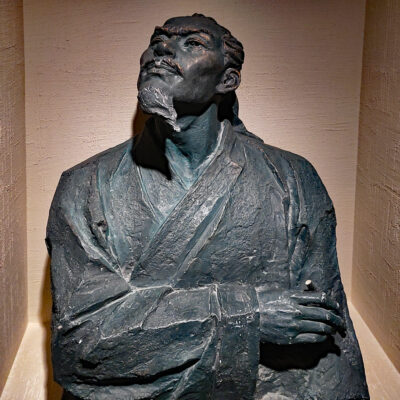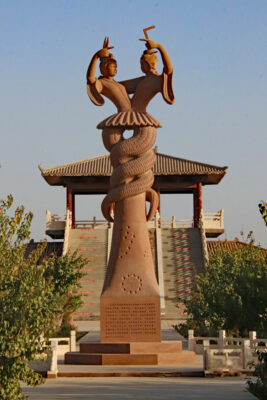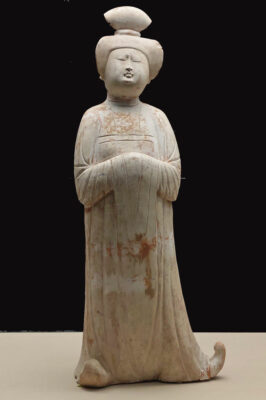Hans van Rappard
17 From: Rappard, H. van (2009). Walking Two Roads ― Accord and Separation In Chinese and Western Thought. Amsterdam: VU University Press, Chapter 6, pp. 172-176.
part 1 – part 2 – part 3 – part 4 – part 5 – part 6 – part 7 – part 8 – part 9 – part 10 – part 11 – part 12 – part 13 – part 14 – part 15 – part 16 – part 17
Having dealt at some length with the Chinese and Western ways of thinking the question arises how the difference between them should be understood. Speaking more specifically, might it be possible to bring the respective key-terms in harmony with each other ― in other words, might accord and separation be made to mutually resonate?
Accord and separation complementing each other
There is an obvious answer to this question. Previous parts would seem to suggest that accord and separation need not be seen as conflicting, but rather as complementing each other.

The first model for such an understanding is found in the Yijing in which yin and yang form a dynamic continuum and alternate continuously. Therefore, both are needed for an all-sided view.
Now, the question is, could this also apply to accord and separation? For an answer we turn to the second chapter of the Zhuangzi,
“Words have something to say. But if what they have to say is not fixed, then do they really say something? … What one calls right the other calls wrong; what one calls wrong the other calls right. But if we want to right their wrongs and wrong their rights, the best thing to use is clarity.
Everything has its ‘that’, everything has its ‘this’. From the point of view of ‘that’ you cannot see it, but through understanding you can know it. So I say, ‘that’ comes out of ‘this’ and ‘this’ depends on ‘that’ ― which is to say that ‘this’ and ‘that’ give birth to each other. But where there is birth there must be death;
where there is death there must be birth … Where there is recognition of right there must be recognition of wrong; where there is recognition of wrong there must be recognition of right.”[1]
Zhuangzi’s language is more difficult than the message he wants to get across, Lao Sze-kwang (Lao Siguang) tells us and helpfully explains that the criterion of right and wrong is always relative to the system of knowledge within which it functions.[2]
But for every system, there is an opposite system. Thus, although they may seem to exclude each other in reality they depend on each other. Failure to see this prompts disputes based on relative and one-sided viewpoints, such as the ‘rights and wrongs’ of the Confucians which may drag on endlessly but are bound to remain fruitless. The sage however,
“illuminates all in the light of Heaven. He too recognizes a ‘this,’ but a ‘this’ which is also ‘that,’ a ‘that’ which is also ‘this’. His ‘that’ has both a right and a wrong in it; his ‘this’ too has both a right and a wrong in it. So, in fact, does he still have a ‘this’ and ‘that’? Or does he in fact no longer have a ‘this’ and ‘that’? A state in which ‘this’ and ‘that’ no longer find their opposites is called the hinge of the Way. When the hinge is fitted into the socket, it can respond endlessly. Its right then is a single endlessness and its wrong too is a single endlessness. So I say, the best thing to use is clarity” (italics added).[3]
It is to be noted that ‘hinge’ of the Way is an unfortunate translation because the metaphor unduly restricts the freedom of the Way to respond. This may well be the reason why other translators render this as, summarising their interpretations, ‘pivot or axis of Dao in the centre of a circle’, which seems more adequate.[4]
Zhuangzi walks two roads at once

What Zhuangzi says is quite in line with the Yijing. Just like yin and yang, ‘this’ and ‘that’ are not complete without each other and hence, both writings avoid taking these terms as dualities, that is, as fundamentally separated and opposed. Indeed, avoiding the state in which ‘this’ and ‘that’ find their opposites is pretty much what the trick comes down to. Because if one does take yin and yang, and ‘this’ and ‘that’, and accord and separation for that matter as opposites, their interconnection is disrupted.
An interconnection is a two-sided affair. On the one hand, it assumes two separate things because otherwise there would be nothing to connect but on the other hand, it must assume a unity because these things are after all interconnected. Failure to see this makes the inherently connected yin and yang and all the rest appear to be separated. And separation is what choice and evaluation bring about and why one is cautioned against picking and choosing. But Zhuangzi walks two roads at once, steering clear of picking and choosing and hence, ‘this’ and ‘that’ don’t find their opposites and neither need accord and separation ― the pairs are not ripped apart, the Way isn’t injured, and its pivot is free to respond unimpededly to all sides.
Having come this far, the business of accord and separation, ‘this’ and ‘that’, yin and yang, and what have you might still seem to be a mere play of words. Indeed, one wonders, where does all this leave us in actual practice?
The pivot or axis metaphor
Looking at the metaphor of pivot or axis in the centre, it would seem to point to a state which is not different from the Confucian mean (zhong) ― the state in which there is no inclination to either side. From this point of view, it is interesting that Ezra Pound translated the title of the Mean as ‘the unwobbling pivot’.
Actually, Zhuangzi’s pivot or axis metaphor is not new to us. It has often been encountered in the previous pages. After all, it refers to the state of the heart-mind before picking and choosing have arisen, that is, the state before intention. The pivot of the Way, then, is the heart-mind before it inclines to one of two sides.
This is a Daoist view, but is it exclusively Daoist? I don’t think it is. What is more, it is not even exclusively Chinese, I think ― I rather think that Zhuangzi’s view does not stand alone and has a far wider resonance.
A state before inclination

Reflect, are we never in a state in which ‘this and that do not find their opposites’? Isn’t it possible for us, in spite of our Western upbringing to be in a state before inclination, a state before intention? Yes, it surely is.
What Zhuangzi referred to is a way of thinking and seeing that was encountered in the sixth part of this essay when a state of consciousness was alluded to which is pre-intentional, that is, a state that is not ‘intendedly’ directed or self-consciously focused. In such a pre-intentional state of heart-mind there is no consciousness of anything in particular and thus, there is not a tad of self-consciousness either. When the attention is not intentionally focused but springs from an immediate response ― a response not mediated by choice and evaluation ― there is no opposition between I and the object attended to.
In other words, there is no ‘this’ opposed to ‘that’, no subject opposed to object. True enough, there is separation but since it does not intentionally separate, harmony is not distorted.
Samuel Coleridge[5], Wordsworth’s friend of many years once wrote,
“I never felt alone in the embrace of rocks and trees”.
In our days, when the greater part of humanity have become city dwellers this romantic line might need rephrasing as, say,
“I never felt alone in the embrace of cars and concrete”.
But, one wonders, how could we possibly feel embraced in such an environment? How on earth could we not feel separate and out of tune?
Actually, our days abound with such embraces ― moments of directly responding to what happens to be at hand; moments of choiceless awareness when the gap between self and situation has not yet opened; moments when we are in a state before intention.
When on arriving at the office a colleague says good morning and is just responded to, we have gone through such an embrace.
Walking through the corridor on the way to the coffee machine we may again be in a state before intention when beholding the carpet, the office doors, the colour of the walls ― until we start thinking of the upcoming holiday or whatever else may adulterate our perception. Negotiating heavy traffic, working on a problem that cried out for solution, a landscape beheld from a train ― all these situations ask, and get, our attention without us having to do anything at all.
Not knowing cars and concrete Linji put the matter in a different way. But according to him as well,
“there is nothing complicated. Just be your ordinary selves in an ordinary life, wear your robes and eat your food, and having nothing further to seek, peacefully pass your time”.[6]
All this happens quite of itself; no inclination, no intention, no self-consciousness are asked for. Not being out of tune with what is there, we may be moved by it.
… the discerning intellect of Man,
When wedded to this goodly universe
In love and holy passion, shall find these
A simple produce of the common day.
William Wordsworth[7]
- Allinson, R.E. (1989). An overview of the Chinese mind. In E. Allinson (Ed.). Understanding the Chinese mind (pp. 1-25). Oxford: Oxford U.P.
- Chan, Wing-tsit. (1963). A sourcebook in Chinese philosophy. Princeton: Princeton U.P.
- Fung, Yu-lan. (Transl). (1931/1995). A Taoist classic: Chuang-tzu. A new selected translation with an exposition of the philosophy of Kuo Hsiang. Beijing: Foreign Languages Press.
- Lao Sze-kwang (1989). On understanding Chinese philosophy: An inquiry and a proposal. In R.E. Allinson (Ed.). Understanding the Chinese mind (pp. 265-293). Oxford: Oxford U.P.
- Legge, J. (Transl). (1891/1962). The texts of Taoism. New York: Dover Publ.
- May, R. (2003). Heidegger’s hidden sources: East Asian influences on his work. In A.L. Macfie (Ed.). Eastern influences on Western philosophy (pp. 315-322). Edinburgh: Edinburgh U.P.
- Ransdorp, R. (2004). The pivot of Dao (translated title; in Dutch). Louvain: Dissertation Catholic University of Louvain.
- Schipper, K. (Transl). (2007). Zhuang Zi ― The complete writings (translated title; in Dutch). Amsterdam: Augustus.
- Schloegl, I. (Transl.). (1976). The Zen teaching of Rinzai. Berkeley: Shambala.
- Watson, (Transl). (1968). The complete works of Chuang Tzu. New York: Columbia U.P.
Notes
[1] Watson, 1968, pp. 39-40
[2] Lao, 1989, p. 282
[3] Watson, 1968, p. 40
[4] Chan, 1963, p. 183; Fung, 1995, p. 44; Lao, 1989, p. 282; Legge, 1962, p. 183; Ransdorp, 2004, p. 61; Schipper, 2007, p. 60
[5] Further reading: Samuel Coleridge
[6] Schloegl, 1976, p. 45
[7] Further reading: Wordsworth




